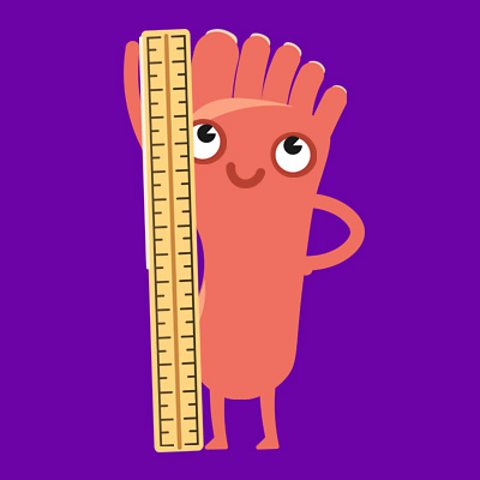Lesson resources
This page contains all of the essential documents you will need to conduct the Feet investigation.Scroll down for the how-to film, lesson plan, lesson resources, letter to send home and student resources.
Don't forget, in addition, we have also prepared a handy classroom presentation you can use in class and other further resources to help you to deliver the investigation. Links to these can be found in the 'Where next?' section below.
How to do the Feet investigation
This step-by-step film explains how to carry out the Feet investigation at your school.
Female:
For this investigation you will need two sheets of A paper, two Cm rulers, these need to have square edges, a pencil, a calculator, measurement tables and guide. Before you begin you should consider, is the floor safe for your bare feet? Avoid any sharp objects and slippery surfaces. Throughout this investigation, make sure you move carefully around the classroom. If the firealarm sounds, exit the building carefully and do not stop to put your shoes on. For this investigation you will need to work in pairs. In your pair, name one person Student 1 and the other Student 2. Student 1 will be measured first with Student 2 recording all measurements. To calculate foot flexibility, first you need to work out the arch height index for your left foot standing andsitting. First, Student 1 should sit. Student 1 must sit with their back straight and their foot flat on the paper. To start, Student 1 should remove their shoes and socks. You can leave your socks on as long as you can still lift your toes.
Female:
Part One: Length of Foot. Take one sheet of A paper. Place your ruler on the paper parallel to the shorter edge. Use your ruler to draw a straight line across the width of the paper. This should be a ruler width away from the edge. Label this Line A. Place the paper on the floor near to Student 1. Student 1 next will need to put their left foot on the paper. Student 2 shouldmake sure Student E's heel is only touching the line and not on it. Once in position, Student 1 must keep their foot in this position. Using a ruler, draw a straight line by the top of the longest toe. This line should be parallel to Line A. Label this Line B.
Female:
Part Two: Height of Foot. Carefully measure the distance between A and B and record it on your measurement sheet. Remember, Student 1 must not move their foot while it's being measured. Calculate the mid-point between A and B by dividing this measurement in half. Record this measurement on your sheet. Using a ruler, mark the mid-point between Lines A and B and drawanother straight line on the instep of the foot exactly on this mark. This line needs to be parallel to Lines A and B. Label this Line D. Next, it's time to measure the height of Student E's foot. To measure the height, stand one ruler next to the inside of the foot, precisely on the mid-point line. Hold a second ruler on the top of the foot, in front of the first ruler, parallel to the floor.Where it touches the upright ruler on the mid-point is the height of the foot. If you have trouble seeing this measurement, ask your teacher for assistance. Don't forget, if the cm mark is not at the bottom of the ruler, you will need to do a little bit more maths to correctly record the height of the foot. To do this, measure how far the cm mark is from the bottom of the ruler. Record this onyour sheet. Then, you will need to add this measurement of the distance from the cm mark from the end of the ruler, to the height of the foot recorded to get an accurate final measurement. Make a note of this measurement on your sheet.
Female:
Part Three: Lines A to C. Ask Student 1 to lift up their toes a little. Slide the ruler under their toes until you feel it touch the ball of their foot. Remember to be gentle so you do not hurt their foot. Use this ruler to draw another straight line here, parallel to Lines A, B and D. Label it C. Carefully measure the distance between Line A and Line C. Write this down on your sheet. Onceyou have all your measurements, repeat Parts One to Three, but with Student 1 standing up. Turn your piece of A paper over, this will avoid any confusion with lines. You can label on the paper which measurement is for standing and which is for sitting down. Student 1 will stand up straight with their right foot a shoulder width from their left foot. Their arms must be by their sides with theirheel touching this line. If needed, Student 1 can have assistance to remain standing. After you've completed collecting Student E's measurements, wash your hands. Then swap over and repeat all steps again, both seated and standing, with Student 2 using a clean piece of paper. Once all measurements have been taken, wash your hands once more.
Female:
Part Four: Final Calculations. Now you can use your measurements to calculate foot flexibility. To do this, you will need to work out the arch height index of the foot for both the standing and sitting measurements. Divide the height of your foot by the distance A to C. Do this for both your standing and sitting measurements. Now, divide the arch height index of the standing bythe sitting result. The final figure will tell you how flexible your foot is. 1 is very inflexible, 0.1 is very flexible. Record to two decimal places the final figure for each foot measured, ready for your teacher to calculate your class's modal foot flexibility.
Lesson plan
This is a quick-start two page lesson plan with an overview of activities, resources and timings. See the teacher resource for additional detail.
Teacher resource
This is the full teacher resource with detailed information on how to complete the investigation, including background information, starter activity and investigation instructions.
Feet investigation cross-curricular links
A downloadable resource to support the Feet Investigation within other areas of the curriculum.
Student worksheet
Use this chart in conjunction with the teacher resource to help students measure their feet.


